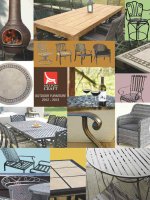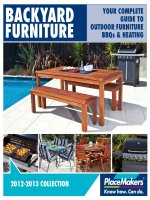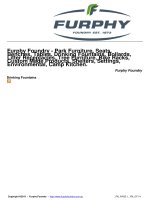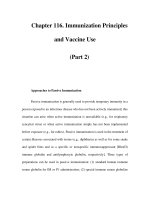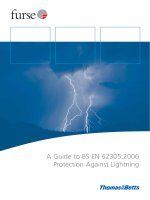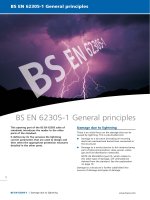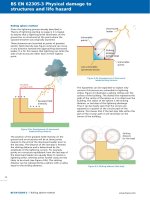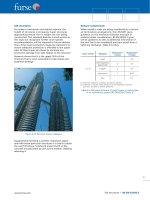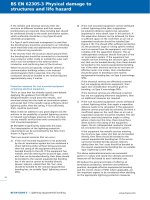BS EN 581 2 2009 outdoor furniture seating and tables for camping, domestic and contract use part 2 mechanical safety
Bạn đang xem bản rút gọn của tài liệu. Xem và tải ngay bản đầy đủ của tài liệu tại đây (764.27 KB, 22 trang )
BRITISH STANDARD
BS EN 581-2:2009
Outdoor furniture —
Seating and tables for
camping, domestic and
contract use
w
w
w
.b
ab
ak
e
.c
om
Part 2: Mechanical safety requirements
and test methods for seating
ICS 97.140; 97.200.30
NO COPYING WITHOUT BSI PERMISSION EXCEPT AS PERMITTED BY COPYRIGHT LAW
BS EN 581-2:2009
National foreword
This British Standard is the UK implementation of EN 581-2:2009. It
supersedes DD ENV 581-2:2000 which is withdrawn.
The UK participation in its preparation was entrusted to Technical
Committee FW/0/2, Domestic & contract furniture.
A list of organizations represented on this committee can be obtained on
request to its secretary.
This publication does not purport to include all the necessary provisions
of a contract. Users are responsible for its correct application.
w
w
w
.b
ab
ak
e
.c
om
Compliance with a British Standard cannot confer immunity
from legal obligations.
This British Standard
was published under the
authority of the Standards
Policy and Strategy
Committee on 30 June
2009.
© BSI 2009
ISBN 978 0 580 58776 4
Amendments/corrigenda issued since publication
Date
Comments
BS EN 581-2:2009
EUROPEAN STANDARD
EN 581-2
NORME EUROPÉENNE
EUROPÄISCHE NORM
April 2009
ICS 97.140; 97.200.30
Supersedes ENV 581-2:2000
English Version
Outdoor furniture - Seating and tables for camping, domestic
and contract use - Part 2: Mechanical safety requirements and
test methods for seating
Außenmöbel - Sitzmöbel und Tische für den Camping-,
Wohn- und Objektbereich - Teil 2: Mechanische
sicherheitstechnische Anforderungen und Prüfverfahren für
Sitzmöbel
Mobilier d'extérieur - Sièges et tables à usages
domestique, collectif et de camping - Partie 2: Exigences et
essais de sécurité mécanique des sièges
This European Standard was approved by CEN on 28 February 2009.
.c
om
CEN members are bound to comply with the CEN/CENELEC Internal Regulations which stipulate the conditions for giving this European
Standard the status of a national standard without any alteration. Up-to-date lists and bibliographical references concerning such national
standards may be obtained on application to the CEN Management Centre or to any CEN member.
ab
ak
e
This European Standard exists in three official versions (English, French, German). A version in any other language made by translation
under the responsibility of a CEN member into its own language and notified to the CEN Management Centre has the same status as the
official versions.
w
w
w
.b
CEN members are the national standards bodies of Austria, Belgium, Bulgaria, Cyprus, Czech Republic, Denmark, Estonia, Finland,
France, Germany, Greece, Hungary, Iceland, Ireland, Italy, Latvia, Lithuania, Luxembourg, Malta, Netherlands, Norway, Poland, Portugal,
Romania, Slovakia, Slovenia, Spain, Sweden, Switzerland and United Kingdom.
EUROPEAN COMMITTEE FOR STANDARDIZATION
COMITÉ EUROPÉEN DE NORMALISATION
EUROPÄISCHES KOMITEE FÜR NORMUNG
Management Centre: Avenue Marnix 17, B-1000 Brussels
© 2009 CEN
All rights of exploitation in any form and by any means reserved
worldwide for CEN national Members.
Ref. No. EN 581-2:2009: E
BS EN 581-2:2009
EN 581-2:2009 (E)
Contents
Page
Foreword ..............................................................................................................................................................3
Scope ......................................................................................................................................................4
2
Normative references ............................................................................................................................4
3
Terms and definitions ...........................................................................................................................4
4
General test conditions .........................................................................................................................5
5
5.1
5.2
Test equipment and apparatus.............................................................................................................5
Rolling cylinder ......................................................................................................................................5
Test floor.................................................................................................................................................6
6
6.1
6.1.1
6.1.2
6.2
6.2.1
6.2.2
6.2.3
Test methods and requirements ..........................................................................................................6
Testing, general .....................................................................................................................................6
Stability ...................................................................................................................................................6
Test sequence and test parameters.....................................................................................................7
Requirements .........................................................................................................................................8
General safety requirements ................................................................................................................8
Stability requirements ...........................................................................................................................8
Mechanical safety requirements ..........................................................................................................8
7
7.1
7.2
Instruction for use .................................................................................................................................8
General ....................................................................................................................................................8
Marking for mobile loungers ................................................................................................................8
8
Test report ..............................................................................................................................................9
.b
ab
ak
e
.c
om
1
w
w
w
Annex A (normative) Additional test method for seating with a multi-position back rest ....................... 10
A.1
Fatigue test on back rest mechanism .............................................................................................. 10
A.1.1 Purpose of the test ............................................................................................................................. 10
A.1.2 Test procedure .................................................................................................................................... 10
Annex B (normative) Test methods and requirements for loungers .......................................................... 11
B.1
Introduction ......................................................................................................................................... 11
B.2
Strength tests ...................................................................................................................................... 12
B.2.1 Test procedure .................................................................................................................................... 12
B.3
Stability ................................................................................................................................................ 15
B.3.1 Test procedure .................................................................................................................................... 15
B.4
Test sequence and test parameters.................................................................................................. 17
B.5
Requirements ...................................................................................................................................... 18
B.5.1 General safety requirements ............................................................................................................. 18
B.5.2 Stability requirements ........................................................................................................................ 18
B.5.3 Mechanical safety requirements ....................................................................................................... 18
Annex C (informative) Purchase information (Guideline) ............................................................................ 19
2
BS EN 581-2:2009
EN 581-2:2009 (E)
Foreword
This document (EN 581-2:2009) has been prepared by Technical Committee CEN/TC 207 “Furniture”, the
secretariat of which is held by UNI.
This European Standard shall be given the status of a national standard, either by publication of an identical
text or by endorsement, at the latest by October 2009, and conflicting national standards shall be withdrawn at
the latest by October 2009.
Attention is drawn to the possibility that some of the elements of this document may be the subject of patent
rights. CEN [and/or CENELEC] shall not be held responsible for identifying any or all such patent rights.
This document supersedes ENV 581-2:2000
This text is one part of a general standard concerning safety and performance requirements for outdoor
seating and tables.
The work programme of CEN/TC 207/WG4 includes the following parts:
Outdoor furniture – Seating and tables for camping, domestic and contract use – Part 1:
General safety requirements
EN 581-3
Outdoor furniture – Seating and tables for camping, domestic and contract use – Part 3:
Mechanical safety requirements and test methods for tables
CEN/TR 581-4
Outdoor furniture – Seating and tables for camping, domestic and contract use – Part 4:
Requirements and test methods for durability under the influence of climatic conditions
.c
om
EN 581-1
w
.b
ab
ak
e
www.bzfxw.com
w
w
According to the CEN/CENELEC Internal Regulations, the national standards organizations of the following
countries are bound to implement this European Standard: Austria, Belgium, Bulgaria, Cyprus, Czech
Republic, Denmark, Estonia, Finland, France, Germany, Greece, Hungary, Iceland, Ireland, Italy, Latvia,
Lithuania, Luxembourg, Malta, Netherlands, Norway, Poland, Portugal, Romania, Slovakia, Slovenia, Spain,
Sweden, Switzerland and the United Kingdom.
3
BS EN 581-2:2009
EN 581-2:2009 (E)
1
Scope
This part of EN 581 specifies the mechanical safety requirements and test methods of outdoor seating for
camping, domestic and contract use for adults, without regard to materials, design/construction or
manufacturing processes.
This document does not apply to outdoor furniture for severe contract use, where higher requirements may be
necessary nor to removable upholstery and coverings, permanently fixed furniture and street furniture.
The test requirements contained within this European Standard are based on use by persons weighing up to
110 kg.
Information regarding ageing and degradation caused by light, temperature and moisture has not been
included.
Annex A (normative) specifies additional test methods for seating with multi-position back rests.
Annex B (normative) specifies test methods for loungers.
Annex C (informative) specifies guidelines for purchase information.
Normative references
om
2
.c
The following referenced documents are indispensable for the application of this document. For dated
references, only the edition cited applies. For undated references, the latest edition of the referenced
document (including any amendments) applies.
ab
ak
e
www.bzfxw.com
w
.b
EN 581-1, Outdoor furniture – Seating and tables for camping, domestic and contract use – Part 1: General
safety requirements
w
w
EN 1022:2005, Domestic furniture – Seating – Determination of stability
EN 1728:2000, Domestic furniture – Seating – Test methods for the determination of strength and durability
3
Terms and definitions
For the purposes of this document, the following terms and definitions apply.
3.1
outdoor seating for contract use
outdoor seating intended for non-private use in places with public access, such as restaurants, open-air
swimming pools, beaches, vocational and leisure sites
3.2
outdoor seating for domestic use
outdoor seating intended for private use in places use without public access such as gardens, winter gardens,
terraces, balconies etc.
3.3
outdoor seating for camping use
outdoor seating foldable or knock-down and light-weight, intended for use in connection with camping and
travelling
4
BS EN 581-2:2009
EN 581-2:2009 (E)
3.4
stool
seating without back rest, or with the top of the back rest less than 100 mm from the seat
3.5
multi-position chair
chair with a back rest adjustable in inclination and with fixed or adjustable seat
3.6
bench
multi-place seating with or without back rest, with or without arm rests
3.7
lounger
seating without wheels intended for reclined posture
3.8
mobile lounger
lounger supplied with wheels and possibly handles
NOTE
om
3.9
foot rest
part intended to support the feet of the sitter
A foot rest may be permanently attached to the structure of the seating.
.c
3.10
leg rest
extension of the seat area intended to support the legs of the sitter
ab
ak
e
www.bzfxw.com
A leg rest may be permanently attached to the seat.
General test conditions
w
w
4
w
.b
NOTE
The preliminary preparation shall be as specified in EN 1728 with the exception of conditioning time which
shall be at least 24 h, instead of one week.
With the exception of seating with a seat and back made of one piece of flexible material (e.g. textile),
attached at the upper and lower edges only, seat and back loading points shall be determined according to
EN 1728.
For seating with a seat and back made of one piece of flexible material (e.g. textile), attached at the upper and
lower edges only, the loading point shall be the lowest point when a rolling cylinder (5.1) is placed in the chair.
The tests are described in terms of the application of forces. Masses can however be used. The relationship
10 N = 1 kg may be used for this purpose.
5
Test equipment and apparatus
5.1
Rolling cylinder
For seating with seat and back made of one piece of flexible material (e.g. textile) the loading position
template shall be a cylinder with a mass of (1 ± 0,5) kg and a diameter of (70 ± 10) mm.
NOTE
For example a suitable length of the cylinder is 200 mm.
5
BS EN 581-2:2009
EN 581-2:2009 (E)
5.2
Test floor
Horizontal, flat and rigid with a smooth surface.
NOTE
6
Some examples of test floor complying with the definition: plastics laminate, bakelite board, steel.
Test methods and requirements
6.1
Testing, general
The tests shall be carried out in the order in which they are presented in Table 1 of this standard.
The additional test method for multi-position back rests is specified in Annex A.
Test methods and requirements for loungers are specified in Annex B.
6.1.1
Stability
.c
om
Carry out the applicable tests according to EN 1022 (see Table 1).
w
w
w
.b
ab
ak
e
www.bzfxw.com
6
BS EN 581-2:2009
EN 581-2:2009 (E)
6.1.2
Test sequence and test parameters
Table 1 — Test sequence and test parameters
Test and sequence
Test parameters
Reference
Camping Domestic Contract
1
Seat and back static load EN 1728:2000, Seat: force, N
6.2.1
testa
10x10 s (±2s) + 1x30 min (±10 s)
1100
1600
2000
-
410
560 max
1100
1300
1300
12 500
25 000
50 000
1000
1000
1000
75 max
100 max
100 max
5 000
10 000
20 000
Seat load, kg
100
100
100
Force, N
190
250
250
75
100
100
-
700
900 b
5 000
10 000
30 000
400
400
400
75
75
100
250
300
400
75
75
100
200
300
300
140
180
180
-
1000
1200
Back: force, N
10x10 s (±2s) + 1x30 min (±10 s)
2
Seat front edge static load EN 1728:2000, Force, N
test
6.2.2
10x10 s (±2) + 1x30 min (±10 s)
3
Seat and back fatigue test for EN 1728:2000, Cycles
6.7
seatinga
Seat: force, N
Back: bending moment, N.m
Fatigue test on back rest See Annex A
mechanism
Cycles
om
4
.c
Back: bending moment, N.m
5
Arm downwards static load EN 1728:2000, Vertical force, N
test
6.6
6
Arm fatigue test
ab
ak
e
www.bzfxw.com
8
9
Leg forward static load test
Leg sideways static load test
Seat impact test c
EN 1728:2000, Seat load, kg
6.12
Horizontal force, N
w
w
7
w
.b
EN 1728:2000, Cycles
6.10
Force, N
EN 1728:2000, Seat load, kg
6.13
Horizontal force, N
EN 1728:2000, Drop height, mm
6.15
10 times
10 Foot rail static test for high EN 1728:2000, Vertical force, N
seating
6.4
11 Forward stability d e
EN 1022
12 Rearward stability d
EN 1022
13 Sideways stability d e
EN 1022
a
If seat and back are of one piece of flexible material (e.g. textile), only the tests on seat shall be carried out.
b
If arm rest is less than 15 mm wide, carry out test with 700 N for contract use.
c
The application point shall be at least 100 mm from the front edge. This test shall not be carried out on seating with a seat
height > 600 mm.
d
In the case of seating which might not fulfil the stability requirements before carrying out any tests, the applicable stability tests may be
carried out before starting the sequence of tests specified in this table.
e
This test is not applicable for seating with a seat height < 200 mm and a mass < 5 kg. The height shall be determined by measuring
from the floor to the upper seating area on the geometrical centre of the unloaded seat.
7
BS EN 581-2:2009
EN 581-2:2009 (E)
6.2
Requirements
6.2.1
General safety requirements
The general safety requirements specified in EN 581-1 shall be fulfilled.
6.2.2
Stability requirements
The stability requirements specified in EN 1022 shall be fulfilled.
6.2.3
Mechanical safety requirements
The requirements are fulfilled during and after testing in accordance with Table 1 when:
there are no fractures of any joint, member or component;
b)
there is no loosening of joints intended to be rigid;
c)
the seating fulfils its function after removal of the test loads.
7
Instruction for use
General
.c
7.1
om
a)
Instruction for use shall be provided in the language(s) of the country where the tables are sold. These
instructions shall be headed "IMPORTANT, RETAIN FOR FUTURE REFERENCE: READ CAREFULLY" in
letters no less than 5 mm high.
ab
ak
e
www.bzfxw.com
w
.b
These instructions shall include at least the following:
name and address of the producer (manufacturer or supplier);
b)
information regarding maintenance;
c)
conditions for use of the product (camping, domestic or contract).
7.2
w
w
a)
Marking for mobile loungers
All mobile loungers not intended to be lifted and moved under the load specified in Table B.1 shall be marked
with a pictogram as an example is shown in Figure 1.
8
BS EN 581-2:2009
EN 581-2:2009 (E)
Figure 1 — Example of pictogram for mobile loungers not intended to be moved when loaded
8
Test report
The test report shall include the following information:
reference to this part of the European Standard;
b)
details of piece of furniture tested;
c)
use of the product (Camping, Domestic or Contract);
d)
any defects observed before testing;
e)
test results according to the applicable clauses;
f)
compliance with the requirements;
g)
details of any deviations from this European standard;
h)
name and address of the test facility;
i)
date of test.
w
w
w
.b
ab
ak
e
.c
om
a)
9
BS EN 581-2:2009
EN 581-2:2009 (E)
Annex A
(normative)
Additional test method for seating with a multi-position back rest
A.1 Fatigue test on back rest mechanism
This test is only applicable to seating with a multi-position back rest.
A.1.1 Purpose of the test
The purpose of the test is to validate the safety of the mechanism used to change the position of the back rest.
A.1.2 Test procedure
om
Place the seating in normal use position, with the feet secured to prevent sliding, and with the back rest in the
most adverse position. If the most adverse position can not be determined, carry out the test with the back
rest in the mid position.
ak
e
.c
Load the seat at the seat loading point determined by point A of the template, with the seat load specified in
Table 1.
ab
The height of the back rest loading points shall be 400 mm above the seat loading point determined according
to 4.3 of EN 1728:2000. They shall be 50 mm from the right and left outer edges of the back rest.
w
w
w
.b
Apply rearwards alternating forces perpendicularly to the back rest, as specified in Table 1 (or Table B.1 for
loungers).
If it is not possible to load the specified points, the bending moment specified in Table 1 (or Table B.1 for
loungers) shall remain constant, i.e. the force applied on the back rest shall be increased proportionately to
the decrease in loading point height.
Carry out the test for the number of cycles specified in Table 1, with the force maintained for (2 ± 1) s.
1 cycle = 1 application of force on the right side and 1 application of force on the left side.
10
BS EN 581-2:2009
EN 581-2:2009 (E)
Annex B
(normative)
Test methods and requirements for loungers
B.1 Introduction
Loungers combine, by their nature and design, the use of sitting and lying rest. Due to their extended length,
they invite a second person to sit. Therefore, they shall be tested for all of these functions individually and in
combination.
ak
e
.c
om
Any extension of the seat section to the full length of the lounger shall meet the requirements as specified
below. Loungers without a particular seat section, (i.e. those without back rest and arm rest), shall be tested
as specified below.
b) Loungers with back rest in the highest
position and without arm rest
w
w
w
.b
ab
a) Loungers without back rest and without
arm rest
c) Loungers with back rest in lowest
position, without arm rest
d) Loungers with back rest in position more
likely to cause failure and with arm rest
Figure B.1 — Pictograms used in this annex
The tests shall be carried out in the order they are presented in this Annex.
NOTE
In the case of loungers which might not fulfil the stability requirements before carrying out any tests, the
applicable stability tests may be carried out before starting the sequence of tests specified in this Annex.
11
BS EN 581-2:2009
EN 581-2:2009 (E)
B.2 Strength tests
B.2.1 Test procedure
B.2.1.1
Seat and back static load test
All adjustable parts shall be put in the position most likely to cause failure.
Apply the downwards force FB.1 at the seat loading point determined according to 4.3 of EN 1728:2000 (point
A) and simultaneously the downwards force FB.2 at the most adverse position between point D and E specified
in Figure B.2.
Apply forces for the number of cycles nB.1 as specified in Table B.1.
The back rest test procedures are specified in EN 1728:2000 clauses 6.2.1 and 6.3, and the parameters are
specified in Table B.1.
NOTE
For a simplified test procedure the seat and back static load test may be performed by carrying out the seat
test followed by the back test with a static load on the seat.
w
w
w
.b
ab
ak
e
.c
om
Dimensions in millimetres
a) lounger with arm rest
b) lounger without arm rest
Figure B.2 — Static test
12
BS EN 581-2:2009
EN 581-2:2009 (E)
B.2.1.2
B.2.1.2.1
Seat and back fatigue test
Seat fatigue test procedure
Apply downwards forces FB 3 for (2 ± 1) s for the number of cycles nB2, as specified in Table B.1, in alternating
order (50% of cycles at G and 50% at H) (see Figure B.3).The points of application in longitudinal direction as
well as any position of adjustable parts shall be in a position most likely to cause failure.
.c
om
Dimensions in millimetres
w
w
w
.b
ab
ak
e
a) examples 1 and 2
b) top view to examples 1 and 2
Figure B.3 — Seat fatigue test
B.2.1.2.2
Back fatigue test procedure
The back rest test procedure is specified in EN 1728:2000 clauses 6.7 and 6.9 and the parameters are
specified in Table B.1.
B.2.1.3
Fatigue test on back rest mechanism
The back rest mechanism fatigue test procedure is specified in Annex A, and the parameters are specified in
Table B.1.
13
BS EN 581-2:2009
EN 581-2:2009 (E)
B.2.1.4
Arm downwards static load test
The arm downwards static load test procedure is specified in EN 1728:2000 clause 6.6, and the parameters
are specified in Table B.1.
B.2.1.5
Arm fatigue test
The arm fatigue test procedure is specified in EN 1728:2000 clause 6.10, and the parameters are specified in
Table B.1.
B.2.1.6
Seat impact test
With the except of the application points which are specified below, the impact test procedure is specified in
EN 1728:2000 clause 6.15 and the parameters are specified in Table B.1.
The application points shall be on the lying section and, if applicable, on foot end locking mechanisms (see
Figure B.4).
The points of impact shall be in the longitudinal direction of seating-lying section, on the points most likely to
cause failure and directly above the locking mechanisms.
w
w
w
.b
ab
ak
e
.c
om
Dimensions in millimetres
a) examples 1 and 2
b) top view to examples 1 and 2
Figure B.4 — Impact test
14
BS EN 581-2:2009
EN 581-2:2009 (E)
B.2.1.7
Lifting test for mobile loungers
Mobile loungers not being marked with the pictogram as specified in 7.2 shall be tested as shown in Figure
B.5.
Apply the load MB.2 as specified in Table B.1 on the geometrical centre line of the lounger surface. The area of
contact of load MB.2 shall have a diameter of (350 ± 50) mm. Lift the foot end of the lounger for the number of
cycles nB.4, specified in Table B.1 up to a height so that only the wheels are in contact with the floor surface.
om
Dimensions in millimetres
ak
e
Point A, as defined in 4.3 of EN 1728:2000
ab
1
.c
Key
w
w
B.3 Stability
w
.b
Figure B.5 — Lifting test
B.3.1 Test procedure
B.3.1.1
Sideways stability
The seat loading points shall be on a line 60 mm from the side, the first point shall be 300 mm from the front,
the others each 600 mm if the distance from the armrest or the rear edge of the lounger is at least 300 mm.
The forces are applied using the loading pad defined in 4.2 of EN 1022:2005.
If the arm rest is more than 400 mm in length apply additional vertical force FB 5 in the centre of it.
Apply simultaneously the downwards forces FB.4 on seat as specified in Table B.1 and the load on the arm rest.
Maintain forces for 5 s.
15
BS EN 581-2:2009
EN 581-2:2009 (E)
Dimensions in millimetres
.c
om
a) lounger with arm rest
ab
ak
e
b) lounger without arm rest
w
Forward stability
w
w
B.3.1.2
.b
Figure B.6 — Example of application points for sideway stability
Apply the downwards force FB.6 as specified in Table B.1 (see Figure B.7). Maintain FB.6 for 30 s minimum.
Dimensions in millimetres
Figure B.7 — Forward stability
16
BS EN 581-2:2009
EN 581-2:2009 (E)
B.4 Test sequence and test parameters
Table B.1 — Test sequence and test parameters
Test and sequence
Test parameters
Reference
Camping Domestic Contract
1
Seat and back static load test
B.2.1.1 and
1100
1600
2000
600
900
900
-
410
560 max
12 500
25 000
50 000
750
1000
1000
75 max
100 max
100 max
5 000
10 000
20 000
100
100
100
Force, N
190
250
250
Back: bending moment, N.m
75
100
100
-
700
900 a
5 000
10 000
30 000
400
400
400
140
180
180
Seat: force FB.1, N
EN 1728:2000, Seat: force FB.2, N
6.2.1
nB.1 : 10x10 s (±2 s)
+ 1x30 min (±10 s)
Back: force, N
10x10 s (±2 s)
+ 1x30 min (±10 s)
2
Fatigue test
mechanism
on
back
rest B.2.1.3 and
Annex A
Cycles
Seat load, kg
ak
e
.c
om
3
Seat and back fatigue test for B.2.1.2 and
Cycles, nB 2
seating
EN 1728:2000, Seat: force FB.3, N
6.7
Back: bending moment, N.m
Arm downwards static load test
EN 1728:2000, Vertical force, N
6.6
5
Arm fatigue test
EN 1728:2000, Cycles
6.10
Force, N
7
8
Seat impact test
B.2.1.6 and
Drop height, mm
EN 1728:2000,
6.15
10 times
B.2.1.7
Masse MB.2, kg
100
100
100
Cycles nB.4
500
1000
2000
Force FB.4, N
600
600
600
Force FB 5, N
250
250
250
Force FB 6, N
600
600
600
w
w
6
w
.b
ab
4
Lifting test
Sideways stability b c
bc
B.3.1.1
B.3.1.2
9
Forward stability
a
If arm rest is less than 15 mm wide, carry out test with 700 N for contract use.
b
In the case of seating which might not fulfil the stability requirements before carrying out any tests, the applicable stability tests may be
carried out before starting the sequence of tests specified in this table.
c
This test is not applicable for seating with a seat height < 250 mm and a mass < 5 kg. The height shall be determined by measuring
from the floor to the upper seating area at L/2 on the centre line of the unloaded lounger.
17
BS EN 581-2:2009
EN 581-2:2009 (E)
B.5 Requirements
B.5.1 General safety requirements
The general safety requirements specified in EN 581-1 shall be fulfilled.
B.5.2 Stability requirements
For sideways and forward stability, when loaded, the lounger shall not overturn.
B.5.3 Mechanical safety requirements
The requirements are fulfilled during and after testing in accordance with Table 1 when:
there are no fractures of any joint, member or component;
2)
there is no loosening of joints intended to be rigid;
3)
the seating fulfils its function after removal of the test loads.
w
w
w
.b
ab
ak
e
.c
om
1)
18
BS EN 581-2:2009
EN 581-2:2009 (E)
Annex C
(informative)
Purchase information (Guideline)
To allow the consumer to select a product that will be suitable for the intended use prior to purchase,
purchase information should be available without the need to open any package. This should include:
a)
identification of the product;
b)
product characteristics such as dimensions, storage information, maintenance…;
c)
conditions for use of the product (camping, domestic or contract).
w
.b
ab
ak
e
.c
om
This list is not complete and both EU and national regulation exist on this subject.
w
w
NOTE
19
BS EN
581-2:2009
BSI - British Standards Institution
BSI is the independent national body responsible for preparing British
Standards. It presents the UK view on standards in Europe and at the
international level. It is incorporated by Royal Charter.
Revisions
British Standards are updated by amendment or revision. Users of British
Standards should make sure that they possess the latest amendments or
editions.
It is the constant aim of BSI to improve the quality of our products and services.
We would be grateful if anyone finding an inaccuracy or ambiguity while using
this British Standard would inform the Secretary of the technical committee
responsible, the identity of which can be found on the inside front cover. Tel:
+44 (0)20 8996 9000. Fax: +44 (0)20 8996 7400.
BSI offers members an individual updating service called PLUS which ensures
that subscribers automatically receive the latest editions of standards.
Buying standards
Orders for all BSI, international and foreign standards publications should be
addressed to Customer Services. Tel: +44 (0)20 8996 9001. Fax: +44 (0)20 8996
7001 Email: You may also buy directly using a debit/credit
card from the BSI Shop on the Website />
ak
e
.c
om
In response to orders for international standards, it is BSI policy to supply the
BSI implementation of those that have been published as British Standards,
unless otherwise requested.
Information on standards
w
w
w
.b
ab
BSI provides a wide range of information on national, European and
international standards through its Library and its Technical Help to Exporters
Service. Various BSI electronic information services are also available which
give details on all its products and services. Contact Information Centre. Tel:
+44 (0)20 8996 7111 Fax: +44 (0)20 8996 7048 Email:
Subscribing members of BSI are kept up to date with standards developments
and receive substantial discounts on the purchase price of standards. For details
of these and other benefits contact Membership Administration. Tel: +44 (0)20
8996 7002 Fax: +44 (0)20 8996 7001 Email:
Information regarding online access to British Standards via British Standards
Online can be found at />Further information about BSI is available on the BSI website at http://
www.bsigroup.com.
Copyright
BSI Group
Headquarters 389
Chiswick High Road,
London, W4 4AL, UK
Tel +44 (0)20 8996 9001
Fax +44 (0)20 8996 7001
www.bsigroup.com/
standards
Copyright subsists in all BSI publications. BSI also holds the copyright, in the
UK, of the publications of the international standardization bodies. Except as
permitted under the Copyright, Designs and Patents Act 1988 no extract may
be reproduced, stored in a retrieval system or transmitted in any form or by any
means – electronic, photocopying, recording or otherwise – without prior written
permission from BSI.
This does not preclude the free use, in the course of implementing the standard,
of necessary details such as symbols, and size, type or grade designations. If
these details are to be used for any other purpose than implementation then the
prior written permission of BSI must be obtained.
Details and advice can be obtained from the Copyright and Licensing Manager.
Tel: +44 (0)20 8996 7070 Email:
